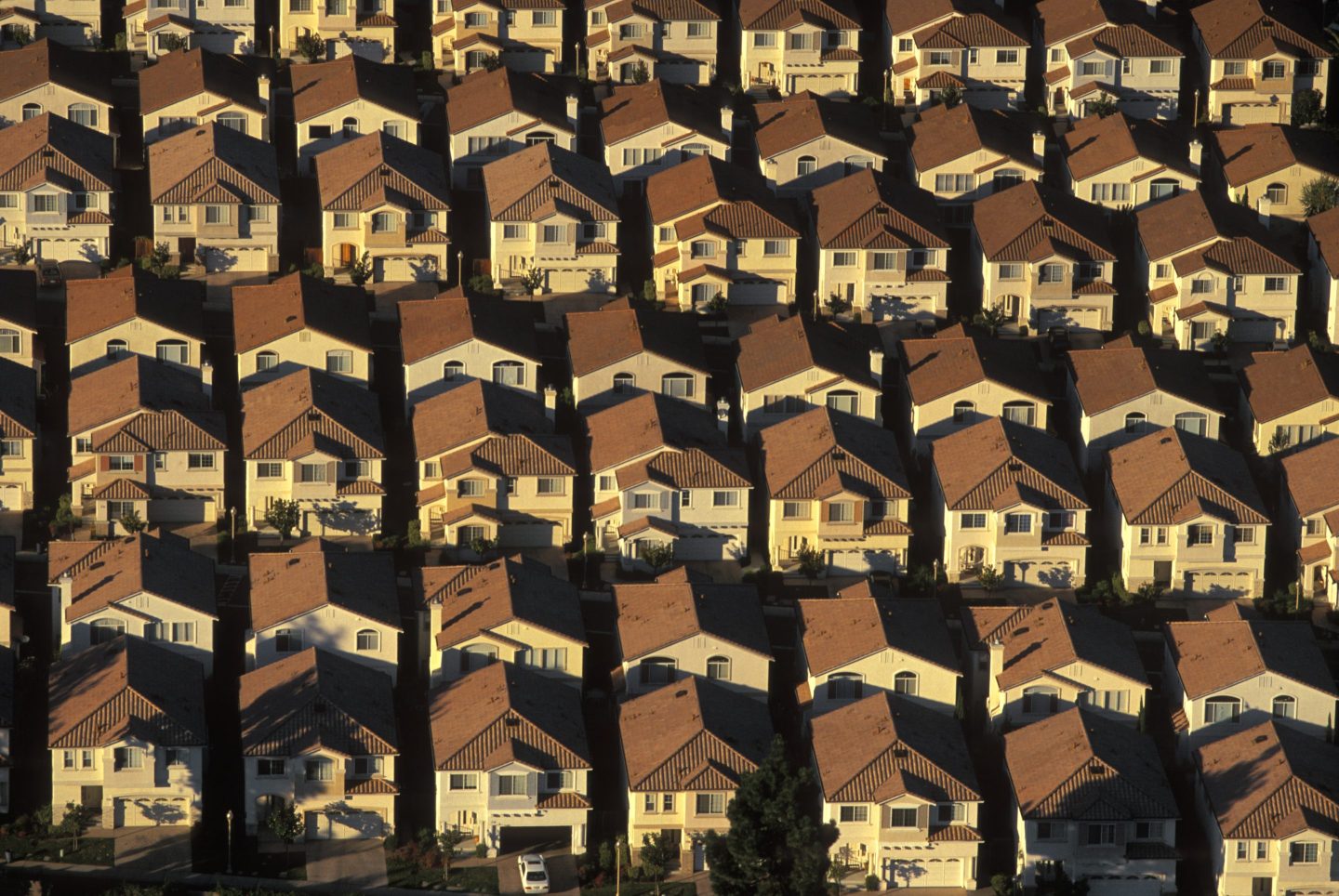房奴卷土重来:可预见未来的新常态

在当今市场上,许多首次置业者都难以支付首付,而其中一大长期负担能力问题则集中在抵押贷款利率不断攀升所导致的月供问题上。根据房地美公司(Freddie Mac)的数据,目前美国30年期固定抵押贷款的利率为7.18%,与新冠疫情初期低于3%的利率形成鲜明对比。
抵押贷款利率飙升导致新购房者的月供增加。房地产数据和分析公司Black Knight的数据显示,月供同比增长了60%(合871美元)。根据Black Knight的数据,2023年7月,30年期固定利率贷款的借款人平均每月本息支付额实际上超过2,300美元,是有史以来平均本息支付额最高的一次。
Black Knight的数据显示,现在,超过一半的购房者每月要支付至少2,000美元的房贷,而四分之一购房者每月支付3,000美元或更多的房贷。与此同时,根据环亚经济数据有限公司(CEIC)的数据,2023年7月,美国人的平均月收入仅为4,600美元。这意味着一些房主可能要把60%以上的工资用于抵押贷款。
请记住,这一本金和利息数额还没有算上房产税和保险等费用。
“从什么时候开始,每月支付2,000美元的抵押贷款成为了常态?”Black Knight的企业研究副总裁安迪·沃尔登在报告中问道。“今年7月,近四分之一购房者的月供超过3,000美元,而2021年这一比例仅为5%。我们谈论可负担能力已经有一段时间了,但这让情况变得更加严峻。”
《财富》美国500强中的投资银行公司Raymond James的股票研究、房屋建筑和住宅房地产投资信托基金(REITS)主管巴克·霍恩称,根据目前的抵押贷款利率、平均收入水平和房价,大多数支付“最低”首付的首次购房者可能需要将月收入的40%以上用于住房。
霍恩对《财富》杂志表示:“在其他条件相同的情况下,相对于接近30%的长期平均水平,这一数字显然是不可持续的。”
对于首次购房者来说,较高的月供尤其具有挑战性。《财富》美国500强里的金融服务公司第一美国不动产经纪公司(First American)的首席经济学家马克·弗莱明告诉《财富》杂志,租房者的家庭月收入中位数为3,900美元。他补充道,这意味着2,000美元的本息支付额将占潜在购房者每月预算的51%。
弗莱明说:“这通常被视为沉重负担,也是我们认为可负担能力处于30年来最低水平的原因之一。较高的利率和持续的价格上涨相结合,对首次购房者的负担能力构成挑战。”
霍恩指出,最终使购房者(不一定是新房主)留在市场上的一些因素包括家庭为首付提供资金支持,以及购房者利用现有房屋销售的“可观”房屋净值来抵消新房的抵押贷款。
住房负担能力在很大程度上受到美联储(Federal Reserve)提高抵押贷款利率的挑战,因此,几乎无法预测未来什么时候情况能够得到一定缓解(对房主而言)。
弗莱明表示:“在美联储明确不再加息之前,抵押贷款利率将面临上行压力。但鉴于我们刚刚坚定转向加速收紧货币政策,抵押贷款利率的大幅调整可能已经发生。”
总的来说,不断上升的抵押贷款利率,加上住房库存紧张和被压抑的需求,可能会在一段时间内挤压新购房者。
“下调的抵押贷款利率都可能被更高的房价所吸收。”霍恩补充道。“因此,在经济出现更根本性的变化(在更大范围)和家庭资产负债表遭遇破坏之前,目前的抵押贷款支付水平可能是可预见的未来的新常态。”(财富中文网)
译者:中慧言-王芳
在当今市场上,许多首次置业者都难以支付首付,而其中一大长期负担能力问题则集中在抵押贷款利率不断攀升所导致的月供问题上。根据房地美公司(Freddie Mac)的数据,目前美国30年期固定抵押贷款的利率为7.18%,与新冠疫情初期低于3%的利率形成鲜明对比。
抵押贷款利率飙升导致新购房者的月供增加。房地产数据和分析公司Black Knight的数据显示,月供同比增长了60%(合871美元)。根据Black Knight的数据,2023年7月,30年期固定利率贷款的借款人平均每月本息支付额实际上超过2,300美元,是有史以来平均本息支付额最高的一次。
Black Knight的数据显示,现在,超过一半的购房者每月要支付至少2,000美元的房贷,而四分之一购房者每月支付3,000美元或更多的房贷。与此同时,根据环亚经济数据有限公司(CEIC)的数据,2023年7月,美国人的平均月收入仅为4,600美元。这意味着一些房主可能要把60%以上的工资用于抵押贷款。
请记住,这一本金和利息数额还没有算上房产税和保险等费用。
“从什么时候开始,每月支付2,000美元的抵押贷款成为了常态?”Black Knight的企业研究副总裁安迪·沃尔登在报告中问道。“今年7月,近四分之一购房者的月供超过3,000美元,而2021年这一比例仅为5%。我们谈论可负担能力已经有一段时间了,但这让情况变得更加严峻。”
《财富》美国500强中的投资银行公司Raymond James的股票研究、房屋建筑和住宅房地产投资信托基金(REITS)主管巴克·霍恩称,根据目前的抵押贷款利率、平均收入水平和房价,大多数支付“最低”首付的首次购房者可能需要将月收入的40%以上用于住房。
霍恩对《财富》杂志表示:“在其他条件相同的情况下,相对于接近30%的长期平均水平,这一数字显然是不可持续的。”
对于首次购房者来说,较高的月供尤其具有挑战性。《财富》美国500强里的金融服务公司第一美国不动产经纪公司(First American)的首席经济学家马克·弗莱明告诉《财富》杂志,租房者的家庭月收入中位数为3,900美元。他补充道,这意味着2,000美元的本息支付额将占潜在购房者每月预算的51%。
弗莱明说:“这通常被视为沉重负担,也是我们认为可负担能力处于30年来最低水平的原因之一。较高的利率和持续的价格上涨相结合,对首次购房者的负担能力构成挑战。”
霍恩指出,最终使购房者(不一定是新房主)留在市场上的一些因素包括家庭为首付提供资金支持,以及购房者利用现有房屋销售的“可观”房屋净值来抵消新房的抵押贷款。
住房负担能力在很大程度上受到美联储(Federal Reserve)提高抵押贷款利率的挑战,因此,几乎无法预测未来什么时候情况能够得到一定缓解(对房主而言)。
弗莱明表示:“在美联储明确不再加息之前,抵押贷款利率将面临上行压力。但鉴于我们刚刚坚定转向加速收紧货币政策,抵押贷款利率的大幅调整可能已经发生。”
总的来说,不断上升的抵押贷款利率,加上住房库存紧张和被压抑的需求,可能会在一段时间内挤压新购房者。
“下调的抵押贷款利率都可能被更高的房价所吸收。”霍恩补充道。“因此,在经济出现更根本性的变化(在更大范围)和家庭资产负债表遭遇破坏之前,目前的抵押贷款支付水平可能是可预见的未来的新常态。”(财富中文网)
译者:中慧言-王芳
While many first-time home buyers struggle to afford a down payment on a house in today’s market, one of the long-term affordability issues centers on monthly payments resulting from escalating mortgage rates. The current 30-year fixed-rate mortgage is 7.18%, according to Freddie Mac, a stark difference from the sub-3% rates seen during the early days of the pandemic.
The surging mortgage rate results in higher monthly payments for new buyers. Indeed, monthly payments are up 60% (or $871) year-over-year, according to real estate data and analytics firm Black Knight. The average monthly principal and interest payment for borrowers on a 30-year fixed rate loan in July 2023 was more than $2,300, which is the highest average principal and interest payment on record, according to Black Knight.
Now, more than half of homebuyers face a monthly mortgage payment of at least $2,000, while one-fourth are paying $3,000 or more, Black Knight data shows. Meanwhile, average U.S. monthly earnings in July 2023 were just $4,600, according to economic data firm CEIC. That means some home owners could be spending more than 60% of their paychecks on their mortgage.
Keep in mind that principal and interest figure is before factoring in expenses like property taxes and insurance.
“When did the $2,000 monthly mortgage payment become the norm?” questions Andy Walden, Black Knight vice president of enterprise research in the report. “Nearly one in four July homebuyers has payments north of $3,000, up from just 5% in 2021. We’ve been talking about affordability for quite some time now, but this puts the situation in stark relief.”
Based on current mortgage rates, average income levels, and home prices, most first-time home buyers using a “minimal” down payment could be paying more than 40% of their monthly income toward housing, says Buck Horne, director of equity research, homebuilding and residential REITS at Fortune 500 investment banking firm Raymond James.
“All else equal, that number certainly looks unsustainable relative to long-term averages closer to 30%,” Horne tells Fortune.
Higher monthly payments can be particularly challenging for first-time home buyers. The median renter’s monthly household income is $3,900, Mark Fleming, chief economist at Fortune 500 financial services company First American, tells Fortune. That implies that a $2,000 principal and interest payment would represent 51% of the prospective homebuyer’s monthly budget, he adds.
“That’s generally considered a high burden, and one reason why, in our estimation, affordability is at a 30-year low,” Fleming says. “The combination of higher rates and continued price appreciation has made affordability a real challenge for first-time homebuyers.”
Ultimately, some of the factors keeping buyers—not necessarily new homeowners—in the market include families providing financial support for a down payment and buyers using “significant” home equity from existing home sales to offset a mortgage on a new house, Horne says.
With housing affordability largely being challenged by mortgage rate increases by the Fed, it’s nearly impossible to predict when prospective homeowners could get some relief.
“Until the Fed is clearly done raising interest rates, there will be upward pressure on the mortgage rate,” Fleming says. “But given the historically fast and assertive pivot to tighter monetary policy we have just experienced, it’s likely that the majority of the adjustment in mortgage rates has already occurred.”
Overall, rising mortgage rates—coupled with tight housing inventory and pent-up demand—are likely to squeeze new buyers for a while.
“Any relief in mortgage rates is likely to get absorbed by even higher home prices,” Horne adds. “So until something more fundamental breaks within the larger economy and disrupts household balance sheets, the current level of mortgage payments might be the new normal for the foreseeable future.”













